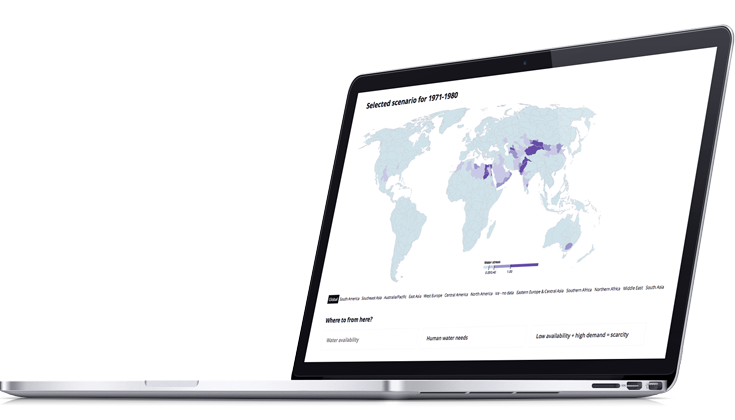As water use increases, it becomes more difficult to access the resource sustainably. Water users need to handle conflict or cooperation, as well as avoiding breaching ‘planetary boundaries’, and eating into ‘environmental flow requirements’. There is pressure on the water resource - we say that it is “stressed”.
Featured analysis
A simple way of assessing water stress is to calculate what percentage of available water is being used (‘use-to-availability ratio’). Specifically, blue water stress is the percentage of water used from rivers, lakes and aquifers.
Interpretation:
- High values may mean that
- human water use is not leaving enough water to meet environmental water needs
- some users may find it difficult to have access to water. Water issues may be on the political agenda, and households may experience water insecurity
- water levels are low, so navigation may not be possible, water quality may be insufficient, or the water cannot be collected or pumped
- Values greater than 100% mean that water is being used from sources not counted in the analysis, e.g. Interbasin water transfers, or unsustainable fossil groundwater
- Analyses often distinguish between low stress (20%), moderate stress (40%) and high stress (70%). These thresholds are only indicative – a way of highlighting potential hotspots before focussing on specific impacts.
Globally, water stress has been increasing over time, mainly because of increasing water consumption, especially for water-dependent products such as food. Irrigation is the largest water user globally, and in most regions.
Water stress can be thought of as demand-driven scarcity, while water shortage is population-driven. Stress can occur even with a small population if water use is sufficiently high and water availability sufficiently low.
If water use is high, stress can be relieved by reducing water use. Increasing water productivity means that the same products or services can be provided with lower water use. Alternatively, lower water use products and services could be produced. Exports of water-intensive products (‘virtual water exports’) could be reduced, and imported instead from water-rich regions (‘virtual water imports’).
If water use cannot be reduced, then stress can be relieved by increasing water availability. Possible water sources include desalination, interbasin water transfers, and capturing non-productive evaporation. Increasing water storage may help if there are times with surplus water.
Key assumptions:
The interpretation of the indicator changes depending on how water availability and use are calculated. Other results can be viewed in the exploration tool. For the results shown:
- Water availability and consumption data is estimated using the WaterGap2 model, with the setup for the publication by Kummu et al. 2016. A number of other models could be used. At global scale, models are required to get a consistent dataset over time and space – harmonising observed data.
- Water availability is:
- aggregated to the level of “Food production units” (as shown on the map). Within these regions, we assume the water can be moved around (in pipes, tankers, buckets…), and that water from outside these regions would only be used after stress does occur. If we use a larger area, we assume water can be moved further, which increases the water available and reduces stress.
- summed over decades. We assume it is possible to store water (e.g. reservoirs, water tanks, aquifers) or products (e.g. food) so that water surpluses in one month or year can be used in another, but capacity is not large enough to store water or products over more than 10 years
- allocated between regions proportional to discharge, in large basins – rather than water being available only where it rains, some of the water is accessible to downstream regions. In reality, water availability depends on actual upstream water withdrawals and water allocation rules.
- Water use is:
- calculated as water consumption rather than water withdrawals, assuming that users return some of the water to the river. Stress may be underestimated if these ‘return flows’ are not available to other users (e.g. poor water quality, flowing directly to the sea). Using water withdrawals would overestimate stress by assuming that return flows are never available.
- aggregated from water consumption estimates for several sectors: potential irrigation water requirements, and domestic, livestock, industrial and power plant cooling. This broadly captures the main water uses but ignores, for example, the changes due to hydropower. Potential irrigation water requirements assume that water is always available when it is needed. Restricting the water that could be accessed would lower stress, but may not capture what people actually do to access water, e.g. pumping from fossil groundwater.

Dig deeper!
Explore this data in a full interactive visualisation - change assumptions, and zoom in to specific regions and water sectors
Water Stress
Water stress refers to the impact of high water use relative to water availability.
Further reading
Submit a topic?
Have you done research related to water scarcity? Send us some information and we may publish your research in the Water Scarcity Atlas. Please email us at info@waterscarcityatlas.org
Feedback
Want to give us a feedback? Send us an email at info@waterscarcityatlas.org